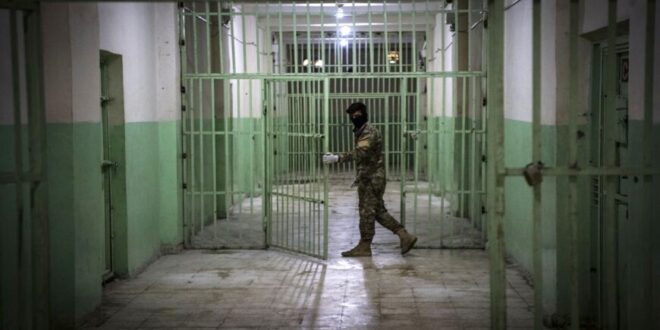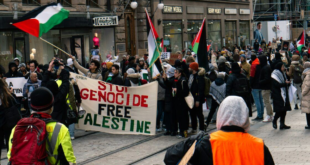Iran’s Islamic Revolutionary Guard Corps is redeploying and building new bases and prisons in its areas of control in northeastern Syria after coming under repeated Israeli and US airstrikes.
Iran’s Islamic Revolutionary Guard Corps (IRGC) opened its own prison in the Zamla gas field in the countryside of Raqqa in northeastern Syria.
According to sources who spoke to Syria TV website on July 12, the prison consists of a one-story building divided into two sections and four interrogation rooms. Half of the prison is underground, and the upper part is surrounded by high berms. The area of the section dedicated to civilian detainees is 55 square meters and contains more than 90 detainees, most of whom are displaced people from the countryside of Homs.
A military source from the prison told Al-Monitor on condition of anonymity, “The prison was equipped after the expulsion of the [Syrian army’s] Fourth Division, on May 13. The prison is surrounded by snipers and fighters with light machine guns. Cars loaded with various ammunition and monitoring devices come to the prison periodically. The prison also includes four-wheel-drive vehicles. Work has begun on digging trenches and stacking up berms to protect the prison from external attacks and prevent prisoners from escaping. The prison is supervised by an Iranian general and has about 20 interrogators of foreign nationalities. It is divided into two sections: one civilian and one military section. Civilians are only released through tribal mediation or on bail after pledging allegiance to Iran. The IRGC soldiers are sometimes imprisoned for discipline and then redeployed.”
The source added, “The IRGC has several prisons in the area, namely the Hamdan airport prison in al-Bukamal, one in the city of al-Mayadin, one next to al-Tala’i camp in Deir ez-Zor and another in the Homs desert in Palmyra. The latter was established at the end of 2019, consisting of three buildings, containing 10 cells, and the director of the prison is a Syrian affiliated with the Iranian militias called Jumaa al-Daher.”
“The new prison in Zamla is completely secluded. All the IRGC prisons bear the banner of the Syrian regime for camouflage purposes to avoid being targeted by airstrikes,” said the source.
Anas Shawakh, a researcher at the Istanbul-based Jusoor Center for Studies, told Al-Monitor, “The recent map we issued showing the sites of foreign military presence in Syria revealed the extent of the expansion of Iranian-affiliated militias in the regime-controlled areas. This expansion was the largest and most visible among all the local or international military forces that share control over the Syrian territories, and it is clear that these militias are seeking, in particular, to expand and increase their security presence more than the military one, especially in the areas east of the Euphrates and the Syrian desert.”
Shawakh added, “The IRGC focuses on the forced recruitment of spies, seeking to create a security breach in the areas controlled by the Syrian Democratic Forces (SDF) to monitor the bases of the international coalition forces. The IRGC also seeks to increase its control of the Syrian desert, which includes a number of oil and gas wells and phosphate fields.”
The IRGC began building a helipad in the Zamla field weeks after taking control of the area in May. It brought in about 33 pieces of heavy machinery, in addition to 40 workers and eight engineers. A center for communicating with aircraft will be attached to the helipad, in addition to fuel tanks and an underground munitions depot. That helipad will also be used for Iranian drones located at the T-4 air base in Homs.
The IRGC had begun maintenance work on the oil wells in the Zamla field, which were damaged by the US-led international coalition bombings and during the battles against the Islamic State (IS), which controlled the area. It brought in specialized engineers to operate the oil and gas wells in the field, with the aim to sell a large part of its production and allocate part of the revenues as salaries to its affiliates, while smuggling the surplus out of Syrian territory or selling it internally.
Najm Eddin Alnajm, a journalist from Raqqa based in Turkey, told Al-Monitor, “The prison building [in Zamla] is not only for prisoners and detainees. It is a military center as well, as the Iranian militias are focusing their efforts on extending military influence and building camps. Iran is also trying to turn the Zamla site into a military base by establishing a helipad as well as expanding and fortifying the existing building. The IRGC has redeployed and moved its military locations from the Syrian desert after Israeli and US airstrikes targeted their sites and inflicted heavy losses on them. This is what prompted it to build new prisons. The IRGC wants to achieve several goals, including avoiding more Israeli and US raids, consolidating its presence — which was recently shaken under the pressure of the Russian military deployment — and threatening US interests in northern and eastern Syria.”
Col. Fayez al-Asmar, a strategic expert based in Turkey who provides military analyzations to a number of local and Arab newspapers, told Al-Monitor, “All the influential players in Syria have multiple centers and prisons in their areas of control, including the IRGC and its militias, which are located in the eastern region. Most of the detainees are arrested on charges of being affiliated with IS or on charges of espionage and providing the coalition and SDF with military information regarding these militias and their movements. Since the IRGC does not completely trust the regime and has its own secret goals, it follows independent work strategies and builds its own prisons close to where its militias are deployed in the desert.”
 Eurasia Press & News
Eurasia Press & News


